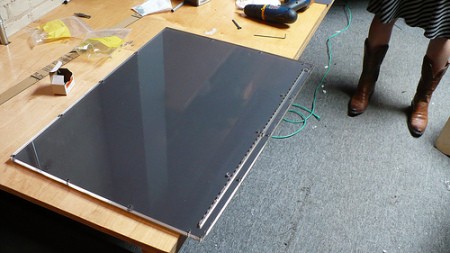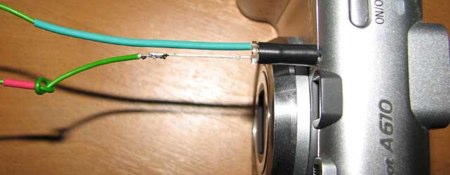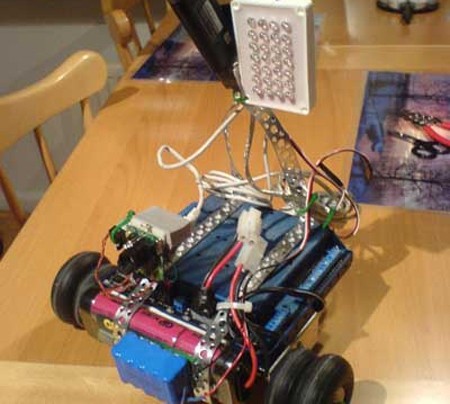[youtube=http://www.youtube.com/watch?v=0u5hAfnq2-4&hl=en&fs=1&rel=0][randy] from F.A.T. tested the theory that infrared LEDs can actually hide you from the prying eyes of surveillance cameras. We’ve previously covered camouflage, IR, and other suggestions for eluding the cameras, but haven’t taken to sewing stuff onto our clothes yet. [randy] lined his hoodie with high-intensity infrared LEDs, hoping to create a halo effect that would hide his head, and tested his results. Unfortunately, his efforts were unsuccessful. He tested many many different combinations and we’re confident in his conclusion that it would be very hard to make this work.
ir245 Articles
Wiimote Head Tracking In Processing

[Manuel] has been playing around with [Johnny Lee]’s Wiimote head tracking code. He’s posted a preliminary port outlining the code in the Processing environment. It relies on darwiinremoteOSC so you won’t see this outside of OSX, but it should help you out if you’re trying to do this is in Processing on another platform.
[via Create Digital Motion]
[photo: nicolasnova]
Defcon 16: Badge Details Released

Defcon will once again be one-upping the sophistication of the conference attendee badges. Wired has just published a preview of this year’s badge. The core is a Freescale Flexis MC9S08JM60 processor. The badge has an IR transmitter and receiver on the front plus eight status LEDs. On the back (pictured below), there is a mode select button, CR123A battery, Data Matrix barcode, and an SD card slot. You can add a USB port to the badge and upload code to it using the built in USB bootloader. All the dev tools needed will be included on the conference CD or you can download the IDE in advance. The low barrier to entry should lead to some interesting hacks. In previous years, you needed a special dongle to program the hardware. There is no indication as to what the badge does out of the box. Releasing the badge early is a first for Defcon and the one pictured isn’t the attendee color, but we’re sure someone will still come up with a clone.
Now comes the fun part: What do you think the best use of this badge will be? Would Defcon be so cavalier as to equip everyone in the conference with a TV-B-Gone? I think our favorite possibility is if someone finds a security hole and manages to write an IR based worm to take over all the badges.
Defcon 14 introduced the first electronic badge which blinked in different patterns. Defcon 15 had a 95 LED scrolling marquee. [Joe Grand] will be posting more specific Defcon 16 badge details to his site after the opening ceremony. Check out more high resolution photos on Wired.
Wiimoteless IR Whiteboard

[Eduard] sent in his IR webcam whiteboard project. He wanted something like the Wiimote version, but without the expense of a Wiimote. He added some film negative to the camera to reduce the amount of visible light picked up by the CCD. (He notes that you might need to pull the IR filter from your camera to get a decent signal.) The pen is the usual IR LED with a power supply. To do the actual work, he wrote a custom application in Java.
Touchkit – IR Multitouch Screen

If you’ve got an extra grand laying around, you can pre-order one of [nortd]’s touchkits. It features a unique custom made acrylic screen with a crap ton of IR LEDs embedded in it. An included IR camera provides the input and a projector (you get to supply your own) is used to light the surface. We mentioned this in our multitouch roundup and you can find a video of it embedded after the break.
Porting CHDK To New Cameras

While researching the CHDK How-To, we came across the team’s instructions for porting the firmware to entirely new cameras. In theory, CHDK should work on any Canon running the DIGIC II or III processor since most of them are running the same VxWorks OS. A dump of the camera’s firmware is required before porting work can begin. On some cameras, the firmware was retrieved using software, but others required a hardware route. Pictured above is a Canon A610 that’s slowly flashing out every bit of its firmware using the built in LED. The photodiode is hooked up to a soundcard where the entire bitstream is recorded. It takes 1-7 hours to read the entire firmware. Once the sound file has been captured, it’s reverted to the original bytes and can then be decompiled with something like IDApro.
Simple Linux Robot With IR Camera

Here’s something else we found while writing up our duplicate Ikea Linux Cluster post. [Janne] also built this simple linux robot. The robot uses the Qwerk robot controller, a webcam with the IR filter removed (something like this one), a usb WiFi card, an IR spotlight, and a set of repurposed model airplane wheels. The WiFi adapter and webcam attach directly to the Qwerk via its on-board usb ports; the servo motors are also connected via built-in ports. Although [Janne] doesn’t post specific instructions, the Qwerk platform seems fairly easy to work with. Have a look at the Qwerk overview for more information.










